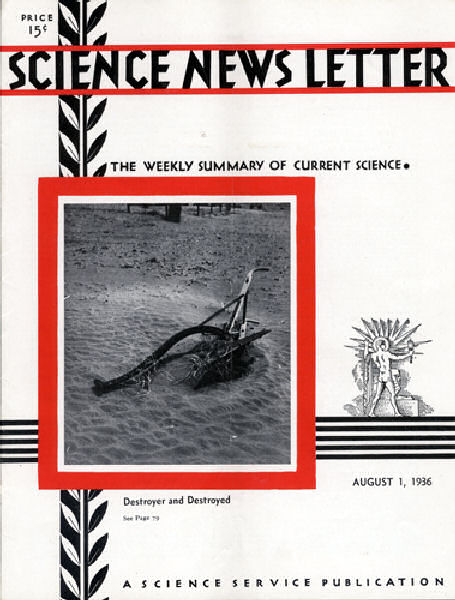From the August 1, 1936, issue

THE CURSE OF THE PLOW
A superstition, false in itself, is sometimes true in a wide symbolic sense never guessed at either by the people who entertained or those who refuted it.
The plow has been the subject of two strange superstitions in America, one by Indians, one by white men. When iron plows were first introduced, something over a century ago, many farmers insisted on retaining their old, admittedly inefficient wooden implements because, they said, iron plows would “poison the soil and make it unfit for growing crops.” They soon got over their nonsense, of course, and presently everybody was using iron plows.
Two or three generations later, when their descendants were streaming out into the Western prairies and plains, in wave after wave of tremendous, land-hungry migration, the hostile Indians held as much enmity against their plows as they did against the men who brought them. Time after time, when raiding Indians attacked wagon trains, they spent their most vindictive arrows, and even their precious powder and shot, on the inanimate farm implements. Captive redskins explained that the plow would “bury the buffalo, and then the Indian could hunt no more.”
That also was a rather absurd notion on the face of it. Yet in a few years, the buffalo were gone as effectually as though the plow had buried them, and the Indian hunted no more. The plow had banished the buffalo as surely as if it had buried that moving larder of the Plains Indian, for plowed wheatland and native grassland range for buffalo could not occupy the same place at the same time.
And now, in years of drought and duststorms and floods, we are seeing how truly “poisonous” the plow can be to the soil itself, if used without knowledge or regard for the laws of nature. For one of the heavy contributing causes of westward migration in the middle of the nineteenth century was the increasing poverty of farmlands in the East, cultivated too closely for permanence of the soil by the early generations of farmers. With the iron plow, and the great progeny of improved agricultural implements that followed it, the farmer could loosen the soil more deeply, turn out stones and roots that would have wrecked his old wooden plow, and thus exposed more and more land to the destructive forces of erosion. So, he had to move on.
And where he went, he repeated the fatal errors he had made in his old home. Not in wantonness or malice, but in sheer ebullience of energy and hopefulness and ambition, he broke with his plow the sod of the Plains. And like a furious genii at the breaking of a seal, the demons of dust and drought have risen to curse the plow. We shall have much ado to exorcise them.
LIGHT WORKS ON SEEDS THROUGH CHLOROPHYLL
Positive evidence that sunlight acts on certain seeds through chlorophyll, the green coloring matter of vegetation, was presented to the spectroscopy conference at the Massachusetts Institute of Technology by Dr. Lewis H. Flint of the U.S. Department of Agriculture.
The discovery opens a new approach to the study of light in relation to seed sprouting and growth, plant metabolism, the distribution of plants, and other equally important allied problems of the science of life.
The research leading to the find was a continuation of that which Dr. Flint has been conducting on the effects of varying wavelengths of light on lettuce seed. Two years ago, he reported to the conference that violet-blue light ranging between 4,400 and 4,800 angstroms and nearly infrared light at about 7,600 angstroms inhibited the growth of the seeds. Yellow, orange, and some types of red light, however, ranging from 5,200 to 7,000 angstroms, were found to promote growth.
This year, he announces he has narrowed the limits of the growth-giving light and that the reddish-orange light in the vicinity of 6,700 angstroms was best for plant growth.
But most significant was his additional discovery that chlorophyll, the green coloring pigment present in the seeds as well as in grown plants, absorbed more light at this 6,700 point and in the two inhibiting ranges than at any other bands.
BLOOD PIGMENT ANALYSIS GIVES CLUE TO OXYGEN USE
First complete analysis of the spectrum of hemoglobin, the complex blood pigment that carries life-giving oxygen from the lungs to the rest of the body, was reported to the spectroscopy conference at the Massachusetts Institute of Technology by Dr. David L. Drabkin of the University of Pennsylvania.
His investigation, made with the spectroscope, reveals much unexpected information concerning the body’s oxygen carrier, whose importance scientists realize well, but about which much remains to be learned.
The research is expected to afford scientists a better understanding of the nature of the union of hemoglobin and oxygen or other gases, and of the energy changes involved in this union.







